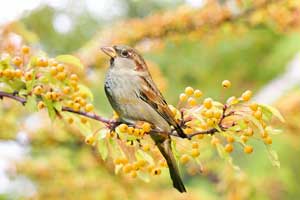Facts about Birds
Posted by A. Douglas / in Science Facts

Birds like this sparrow, like to eat berries from trees.
Discover some interesting bird facts for kids. Birds are not mammals, fish, reptiles or amphibians. Scientists consider birds as their own group. There are over 9000 species of birds that scientists have identified. When most people think of birds, they think of flying. Most birds can fly, but you will find out a few that cannot fly. People have studied birds for a long time. When the Wright Brothers studied flight, part of their research included watching birds glide in the ocean breeze. Find out more interesting bird facts for kids below.
BIRD FACTS FOR KIDS
- Birds that can fly have relatively light bones to help them fly. Some of their bones are hollow. Birds have a large breastbone to help protect their body while they fly. Flightless birds have more sturdy bones like mammals.
- A bird's beak tells a lot about how it eats. Eagles, owls and other meat-eating birds have curved beaks. A hummingbird has a long beak to gather nectar from flowers. A woodpecker has a strong pointed beak to drill into trees to find food.
- Most birds have excellent eyesight. You may have heard of the term "eagle eye". This means that someone has great eyesight. Hunter birds like eagles and hawks have incredible eyesight.
- Birds lay eggs and all birds hatch from eggs when they are born. So which came first: the bird or the egg?
- Many birds build nests to protect their eggs.
- Geese and other birds migrate each year. In the summer they live near the poles where it is cooler. In the winter they fly closer to the equator to escape the harsh winter weather. The bird that has the longest migration flight each year is the Arctic Tern. Their nest is in the north, near the north pole, but in the winter they fly to the other side of the globe (Antarctic).
- Feathers and gravity have allowed a specific bird to be able to move faster than any other animal. The Peregrine Falcon has been measured at speeds above 83.3 m/s (186 mph), but only when stooping, or diving. As far as sustaining flying fast, some birds have been clocked at over 60 miles per hour, but bats (which are mammals) have been recorded flying almost 100 mph.
- All birds have feathers. Even the penguin has feathers that help keep them warm.
- Some birds have fantastic hearing. Owls can hear small mammals like mice crawling through the forest floor at night, even though they may not see the mice. Other nocturnal birds who hunt at night also have great hearing.
- Birds do not have teeth like people. Birds swallow their food whole or in chunks. They rely on their gizzard, which is part of their digestive system, to break their food up into tiny bits.
- All birds have wings and most birds can fly, but not every bird. Birds that cannot fly include Penguins, Ostrich, the Common Rhea, the Emu, Kiwi, Kakapo and the Cassowary. These birds are called flightless birds. Most flightless birds live in the southern hemisphere. There are some flightless birds we know of that are now extinct. Extinct flightless birds include the Dodo, Dinoris and the Moa.
- The ostrich cannot fly, but they are very fast runners. The ostrich can run much faster than the fastest woman or man. Ostriches run up to 35 mph (56 km/hr).
- Humming birds have the fastest wings of any bird. The fastest hummingbirds can beat their wings up to 100 beats per second, which gives them the ability to hover in the air.
- The world's smallest bird is the Cuban Bee Hummingbird. This bird weighs only 0.05 ounces (1.6 grams). The Cuban Bee Hummingbird feeds on the nectar from flowers and is easily confused with an insect.

Hummingbirds can flap their wings fast enough to hover in mid-air.
